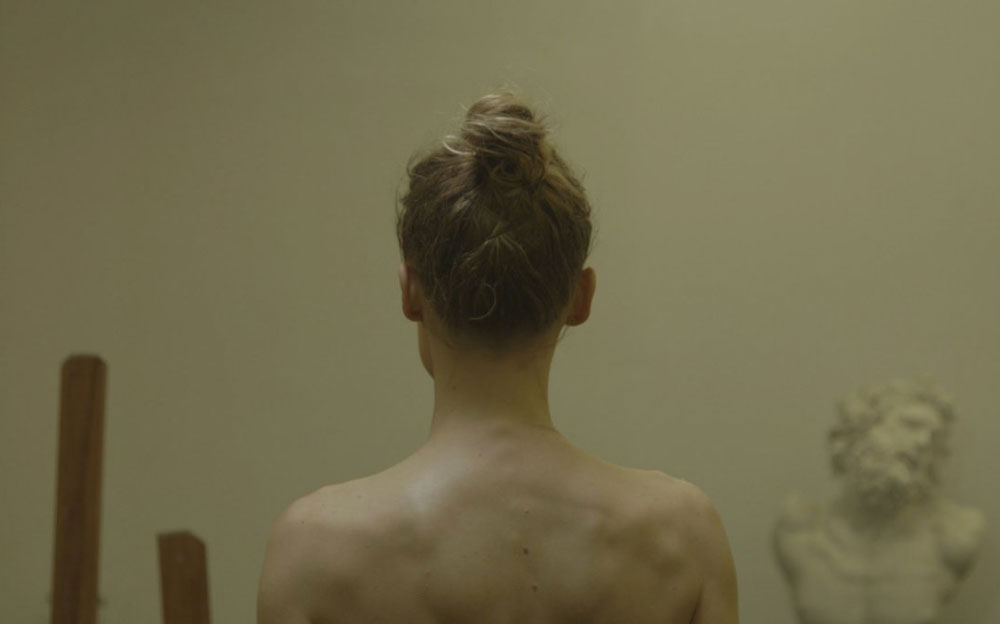Typically, it isn’t considered a good thing when an audience member storms out of your screening, but Frank Mosley couldn’t help but crack a smile when such a thing happened during the festival run for his latest short “Parthenon” since it seemed to validate his reason for making it.
“It was this older gentleman who said, ‘I don’t know what the hell’s going on,” and he got up and walked out halfway through,” says Mosley now, about the generally well-received short which continues its run at the Brooklyn Film Festival this week. “So you’re always going to have these people that just aren’t open to listening, which embodies the characters of the story [of “Parthenon”], forcing somebody to remain captive and really look at something – to look into it and beyond it.”
While “Parthenon” does require some degree of patience, taking course over two halves, it has a heck of a punchline, featuring the dancer/filmmaker Lily Baldwin as an anonymous woman desperate to make her presence known. First seen in the privacy of her bedroom, an argument commences between the woman and her lover (Thiago Martins) over issues that remain abstract but stem from very clear power dynamics in their relationship that she can’t seem to overcome in spite of acutely demonstrating her frustrations. Mosley then takes the action to an art class for which Baldwin is a model, catching the attention of one of the students (Tallie Medel) who has to get past her own implicit biases to observe what’s in front of her in order to capture it on her sketchpad.
Baldwin remains mum during this entire time, yet she exudes her emotions physically, whether in gestures or glances depending on the situation, and it’s devastating to watch her send signals out and watch them go unreturned. Yet Mosley rewards attentiveness both for those onscreen and off as he uses the two segments to connect the dots between what we choose to see and what we don’t and the cultural conditioning that goes into those choices, as well as what it means to see someone in full. It’s quite a bit to accomplish in less than 15 minutes, but “Parthenon” does so and lingers in the mind for far longer, and on its way to its premiere in New York, Mosley took the time to speak about the inspiration behind the film, depriving himself — almost — entirely of dialogue, collaborating with Baldwin and how his own experience made it into the conceptual potboiler.
My recent short that I made right before this was a completely dialogue-driven film, so this was a chance for me to do something totally opposite of what I had just done and to give myself a challenge. A lot of my films really seem to be more about stillness and less than overt action and physicality, so in some ways, I almost feel like “Parthenon” was an action film. [laughs] And I’d been a big fan of Lily Baldwin’s work for a long time because the colorist that she used on some of her early films is one of my best friends from college, so I’d go to his apartment and see him coloring the work of this artist and she was just so incredible to watch. These pieces that she did as a director and star were more like music videos, so there was something about her that really struck me. She had this presence and conveyed such a mixture of emotions without saying anything, so I reached out to her and said, “Hey, we have some mutual friends, but it’d be great to collaborate some time on something together.” That was back in 2009, and we obviously didn’t shoot this until much later, but it was basically written for her as a chance for us to do something together. And if I didn’t get Lily to be the lead, I don’t know if I would’ve done it, to be honest.
Just knowing that Lily’s a dancer and that choreography was a big part of what this would be, what kind of creative partner was she in this?
I was really trying to get back to the roots of conveying a story without words, just with visuals and physicality and silent performances. I’m a huge fan of Samuel Beckett and one of the things I love about Beckett’s plays are the primal, very A to B to C descriptions of some of the action. Everything that happens in this film was entirely scripted. There weren’t moments of improv with physicality, so all the beats in the classroom from look to look to look [between the art students and Baldwin] – this kind of silent duel that’s happening, and the same thing in the physical duel that’s happening in the bedroom [during the first scene], was all beat by beat.
I’m a really big believer in rehearsal, so that bedroom scene was really like a piece of theater because we rehearsed that for several weeks out to really get the timing of that right. Lily really never acted for anybody outside of her own work that she directed, so there was certainly a level of trust that we had to get through the rehearsals because there’s so much intimacy and vulnerability in the piece. It was a challenge for her because the first scene is decidedly a more Lily Baldwin-type piece where she’s using her body in a way that the second scene is totally the opposite, where she has to be still and all she really has is her eyes, but hopefully, we used Lily’s physicality in a new direction.
Was there time or even the inclination to recalibrate the second half at all after shooting the first half?
It was all planned in advance. We shot the film over two consecutive days. The first day was the bedroom, the second day was the classroom. And with the second day, there was no rehearsal [beforehand]. Tallie Medel, the other actress in the scene, didn’t know Lily and Lily didn’t know Tallie, and we wanted to keep it that way so there would be a spontaneity to their performances and a kind of mystery when they’re looking at each other from across this room as opposed to the familiarity between Thiago [Martins] and Lily [in the bedroom scene]. We figured we could make it two days back-to-back and we hustled, but I don’t think if we hadn’t had those rehearsals that we could’ve shot it in the two days that we did.

I’d been a fan of Tallie’s for a long time. In fact, our [director of photography] Cody Stokes was a DP and producer on some of Nathan Silver’s early films like “Uncertain Terms” and “Soft in the Head,” so he had worked with Tallie and thought she was incredible. What really clicked with Tallie is that one, she has a totally different look and feel and tone than Lily, but also, she’s got totally expressive eyes that can convey so much in a close up, much the way Lily is able to express so much with her body. And Tallie, as well as Lily, is a dancer. She’s with the Cocoon Dance Team that just did that movie “Snowy Bing Bongs” and she’s a comedian. She’s so expressive, and just like Lily, she makes her own work. They both do so much as multi-hyphenates, and I think that was important for people [who were going] to be in this film to understand what we were going for with a film that had virtually no dialogue. Thankfully, Tallie also brings a little bit of wry humor into that scene as well. [The art class sketching scene is] almost to me like a moment from a Western between these two women with the tumbleweed going by. When the charcoal breaks [snapping concentration], I think there’s a little bit of humor there, just seeing if [Lily] can break Tallie down to look at her.
Did you actually convene a group of art students or were those simply extras?
What’s funny is that I knew from the get-go that the whole movie is about perception, so to set up the scene showing all these art students, I wanted to make sure that the point of the art students is to show an interpretation of Lily, so they all have their own unique interpretation based on their skills as artists. But at the same time, I wanted each of the artists to have totally different faces themselves, and a totally different feel and tone from one another, to stand out. So the question was do we cast based on ability as artists – people who can draw – or do we cast just based on faces? I wanted to do both, and thankfully my amazing producer Lauren McCune helped find the location and find these people. Some were friends I’d worked with before, but whether you were a friend or an actor or both, the trick was you had to be able to draw, so the bonus was we could get these people who could act and they’d have a presence on camera as much as they could actually draw, and seeing how they all were going to interpret Lily in their own way was a really exciting surprise on that day of the shoot.
How did you actually decide what dialogue to include in the film? It’s somewhat amusing that one of the two lines is “You’re not going to say anything.”
Originally when I wrote the first draft, there was no dialogue between the couple. The [silence in the] classroom scene makes more sense because it’s like everybody’s an art student in the room and it’s supposed to be quiet anyway whereas the bedroom scene, I think the idea was really lofty to try and make it be this extremely silent scene. But at some point, once we started rehearsing, I thought, [the silence] almost feels like it’s drawing attention to itself more than letting it be effortless and believable silence in this room during all the action that’s happening. So that’s what made me decide to put some dialogue back in.
I also decided that it should be the male who says the dialogue because he’s this patriarchy pushing force with words. He’s the guy who speaks because basically he had command of the scene by using his language, but he doesn’t bend to have a communication with Lily in her language [as] she’s attempting to express herself physically and he refuses to play along. So it was important that he’s using these words as a last-ditch effort to try to get what he wants in this duel and [when\ she refuses to budge on that point, they go head to head. Once I found those words, they’re also such primal commands that the scene took on an extra pulse because for every word Thiago would speak, [Lily] would respond with a specific action physically.

Sure, the whole point of the movie for me is about empathy and control. It’s about this interpretation of the female form and of actresses — of female artists [in general] that have been perpetuated throughout history and those statues at the end really say a lot. All these other people in this room [during the class] are drawing Lily as a body and [the scene is] cut with shots of her body, with all these different versions of her, because they’re not really looking at who Lily is. They’re looking at Lily as an object. The only person that really sees Lily as a real person, for who she truly is is Tallie [because] she’s forced to look at her in the eyes and see a real human being in her. And Lily, in a sense, is a statue in that scene, and when you see those statues at the end, she’s the embodiment of all these other women that have come and gone before her that have this repression, this pain that’s being bottled up and not being released. Thankfully for Lily, she’s not a statue yet. It’s not in the past, it hasn’t gone by and she’s able to have through connectivity with another human being in the scene. On the opposite end of that spectrum, that’s what that first scene is there to start up — to show how she doesn’t have that connectivity, even though she is more physically intimate with this man, she’s more intimate with this stranger she meets in [the art class], so there is this whole gender dynamics power struggle in that first scene.
But as much as it is about the male gaze and femininity, I think it’s also about interpretation and perception itself. This is something I thought about myself for a very long time as an actor. You have no control over how people interpret your performance. You can put yourself out there as much as you want and really be vulnerable and intimate and try to express something. But people can always interpret that in a totally different way [than you intended]. And in some ways, Lily is this performer who’s really trying to be seen and heard for who she is and what she wants to express, especially in that [first] scene. And Thiago does not look at her for what she is trying to say and as a performer, she loses her audience when he leaves the room. In the second scene, she’s almost able to hypnotize her audience. She’s able to trap Tallie to really force [her] to look at who she truly is and I would think about when I was a little boy and I used to put on plays in the family living room.
My poor family would be watching my cousins and I perform this play I would put on from like 7 to 11 pm when I was an eight-year-old, and I don’t know how they did it, but the joke I keep going back to is that by 11 o’clock or midnight, they’re trying to go home and I’m like, “No, no, there’s one more scene.” And I would keep going and I would be more intense [to] try to hold them captive for what I wanted to express. So in some ways, this movie is – as much as it is about the male gaze and about this oppression of the female voice – I also just wanted to say something about artists that are trying to be heard, but don’t often get that chance to be seen for what they’re saying.
“Parthenon” will next play at the Brooklyn Film Festival on June 5th at 6:30 pm at Syndicated and June 8th at 10 pm at the Wythe Hotel.





